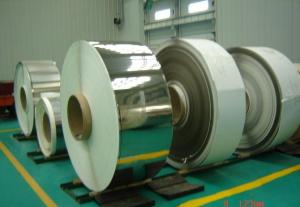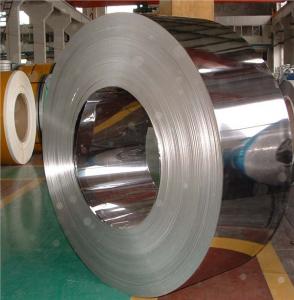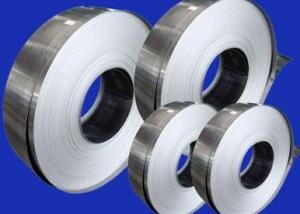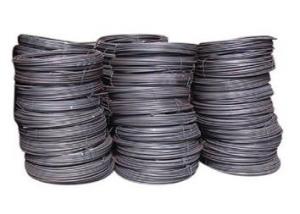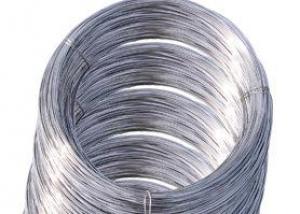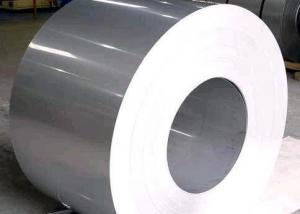Stainless Steel Strips
- Loading Port:
- China Main Port
- Payment Terms:
- TT or LC
- Min Order Qty:
- 20 ton m.t.
- Supply Capability:
- 20000 ton m.t./month
OKorder Service Pledge
OKorder Financial Service
You Might Also Like
Stainless Steel Strip
1.Size:
Thickness: 0.3mm ~~ 6mm, Width: 650mm ~~ 2100mm, Length: to be customized.
2.Material:
SUS201,202,301,304,304L,316,316L ,321 etc.
3.Standard:
AISI,JIS,GB,DIN
4.Finish:
Black, No.1, 2B, 2D, BA, NO.3, NO.4, SB, NO.8, HL
5.Testing:
Each heat number and batch must be tested for both chemical and mechanical properties
Stainless Steel Strip | |
Standard | JIS, AISI, ASTM, GB, DIN, EN |
Property | Stainless steel coil, Stainless steel sheet, Stainless steel plate, stainless steel |
Quality | prime |
Manufacturing Process | factory direct sale |
Surface Treatment | Black, No.1, 2B, 2D, BA, NO.3, NO.4, SB, NO.8, HL |
Main Grade | 201,201,301,302,303,304,321,316,316L,309,310,309H, 310S,431,430,420,430F |
MOQ | 20 ton |
Trade Term | FOB |
Payment term | T/T or L/C |
Price | negotiable |
Packing | Export packing |
Dilvery time | 20days or depend on order quantity |
Container | The capacity for a 20" container:20-24tons |

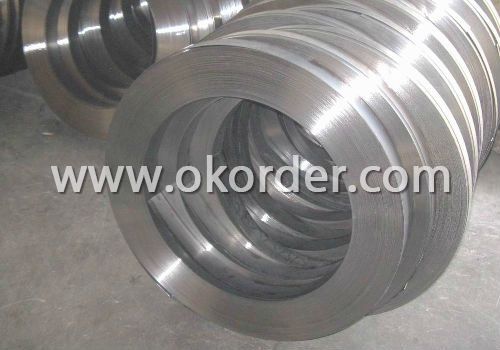
- Q:What are the different types of stainless steel wire constructions?
- There are several types of stainless steel wire constructions, including plain weave, twill weave, Dutch weave, and reverse Dutch weave. Each construction offers different levels of strength, flexibility, and filtration capabilities, making them suitable for various applications such as screening, filtration, and reinforcement.
- Q:How does stainless steel wire perform in corrosive atmospheres?
- Stainless steel wire has a remarkable ability to resist corrosion in various atmospheres, even in environments that are highly corrosive. This is primarily because of the presence of chromium, which forms a protective layer on the wire's surface. This layer acts as a barrier, preventing direct contact between the wire and the corrosive elements in the atmosphere. In environments that are corrosive, such as those with high levels of salt, moisture, or chemicals, stainless steel wire performs exceptionally well. It withstands oxidation, rusting, and general deterioration, ensuring its longevity and reliability in harsh conditions. This makes stainless steel wire an excellent choice for applications where corrosion resistance is crucial. Furthermore, stainless steel wire maintains its mechanical strength and integrity even in corrosive atmospheres. Its physical properties, including tensile strength and flexibility, remain intact, which is vital for its intended uses. This durability ensures that the wire can endure the corrosive elements without compromising its performance or structural integrity. Overall, stainless steel wire is highly recommended for use in corrosive atmospheres due to its exceptional corrosion resistance, durability, and ability to maintain its mechanical properties. Its performance in such environments makes it a reliable choice for various industries, including marine, chemical processing, oil and gas, and many others.
- Q:What are the different types of stainless steel wire springs used in the oil and gas industry?
- There are several types of stainless steel wire springs used in the oil and gas industry, including compression springs, extension springs, torsion springs, and wire forms. These springs are made from stainless steel due to its corrosion resistance and high strength properties, making them suitable for use in harsh environments and high-pressure applications commonly found in the oil and gas industry.
- Q:Can stainless steel wire be used for wire rope slings assemblies?
- Yes, stainless steel wire can be used for wire rope sling assemblies. Stainless steel wire offers excellent corrosion resistance, making it suitable for various applications including lifting heavy loads. It provides durability and strength required for wire rope slings, ensuring reliable and safe operations.
- Q:Can stainless steel wire be used for wire sculpture?
- Yes, stainless steel wire can be used for wire sculpture. It is a popular choice among artists due to its durability, strength, and resistance to corrosion. Stainless steel wire allows for intricate and detailed sculptures that can withstand various weather conditions, making it suitable for both indoor and outdoor displays.
- Q:Does stainless steel wire have any health benefits?
- No, stainless steel wire does not have any direct health benefits. However, it is commonly used in medical equipment and implants due to its corrosion resistance and compatibility with the human body.
- Q:Can stainless steel wire be used for springs in the agricultural industry?
- Indeed, springs used in the agricultural industry can utilize stainless steel wire. Renowned for its remarkable resistance to corrosion, stainless steel proves impeccable for agricultural purposes, particularly when springs are at risk of encountering severe conditions or chemicals. Moreover, stainless steel wire boasts exceptional tensile strength and elasticity, enabling it to endure substantial loads and repeated utilization. These attributes render stainless steel wire springs highly suitable for an array of agricultural machinery and equipment, encompassing tractors, plows, harvesters, and irrigation systems.
- Q:What are the different types of stainless steel wire used in automotive applications?
- There are several different types of stainless steel wire that are commonly used in automotive applications. These wires are chosen based on their specific properties and characteristics, as well as the requirements of the application. 1. Austenitic stainless steel wire: This type of stainless steel wire is the most commonly used in automotive applications. It is known for its excellent corrosion resistance, high ductility, and good strength. Austenitic stainless steel wire is typically used in components such as exhaust systems, fuel lines, and brake lines. 2. Martensitic stainless steel wire: Martensitic stainless steel wire is known for its high strength and hardness. It is often used in automotive applications where high tensile strength and resistance to wear and corrosion are required. Martensitic stainless steel wire is commonly used in components such as springs and fasteners. 3. Ferritic stainless steel wire: Ferritic stainless steel wire is characterized by its high resistance to corrosion and heat. It is commonly used in automotive applications where high temperatures or exposure to corrosive environments are a concern. Ferritic stainless steel wire is often used in exhaust systems and catalytic converters. 4. Duplex stainless steel wire: Duplex stainless steel wire is a combination of austenitic and ferritic stainless steels. It offers a balance of strength and corrosion resistance, making it suitable for automotive applications that require high strength and resistance to corrosion. Duplex stainless steel wire is commonly used in components such as shafts, springs, and fasteners. 5. Precipitation-hardening stainless steel wire: Precipitation-hardening stainless steel wire is known for its high strength and excellent corrosion resistance. It is often used in automotive applications that require components with high strength-to-weight ratios, such as suspension components. Overall, the choice of stainless steel wire for automotive applications depends on the specific requirements of the component or system. Factors such as corrosion resistance, strength, and temperature resistance are all taken into consideration when selecting the appropriate type of stainless steel wire.
- Q:What are the different types of stainless steel wire grades for different applications?
- There are several different types of stainless steel wire grades available for various applications. Some of the commonly used grades include: 1. Austenitic stainless steel (300 series): This grade is known for its excellent corrosion resistance, high ductility, and good formability. It is commonly used in applications that require resistance to chemical and atmospheric corrosion, such as in food processing, chemical industries, and architectural applications. 2. Martensitic stainless steel (400 series): This grade is characterized by its high strength and hardness. It is often used in applications that require high wear resistance, such as in cutlery, surgical instruments, and industrial equipment. 3. Ferritic stainless steel (400 series): This grade has similar properties to martensitic stainless steel, but with better corrosion resistance. It is commonly used in applications that require resistance to stress corrosion cracking, such as in automotive exhaust systems and heat exchangers. 4. Duplex stainless steel: This grade combines the properties of both austenitic and ferritic stainless steels. It offers high strength, good weldability, and improved resistance to stress corrosion cracking and pitting. It is commonly used in applications that require high strength and corrosion resistance, such as in chemical processing plants, oil and gas industries, and marine environments. 5. Precipitation-hardening stainless steel: This grade can be heat treated to achieve high strength and hardness. It is often used in applications that require good mechanical properties, such as in aerospace components, nuclear reactors, and high-performance tools. It is important to choose the appropriate stainless steel wire grade based on the specific requirements of the application, considering factors such as corrosion resistance, strength, formability, and cost. Consulting with a materials engineer or stainless steel supplier can help determine the most suitable grade for a particular application.
- Q:What are the different wire diameter measurement methods for stainless steel wire?
- Stainless steel wire can be measured using various methods to determine its diameter. These methods include: 1. Utilizing a micrometer: This tool, consisting of a calibrated screw and a scale, is commonly employed for precise wire diameter measurements. 2. Employing optical measurement: In this method, a microscope or digital camera captures an image of the wire, which is then analyzed using software to determine its diameter. 3. Adopting laser measurement: Laser measurement devices utilize laser beams to accurately measure the wire's diameter without any contact, making them ideal for measuring thin wires. 4. Employing wire gauges: Wire gauges are cylindrical tools with marked diameters. By passing the wire through the appropriate hole, the diameter can be determined based on the size of the hole it fits through. 5. Implementing wire drawing measurement: This method involves passing the wire through a series of progressively smaller dies to reduce its diameter. The size of the die used can then be used to ascertain the wire's diameter. Each method possesses its own set of advantages and limitations. Factors such as wire thickness, required accuracy, and equipment availability should be considered when selecting the most suitable method to ensure precise and dependable measurements of stainless steel wire diameter.
1. Manufacturer Overview |
|
|---|---|
| Location | Hebei,China |
| Year Established | 1989 |
| Annual Output Value | Above US$160 Thousand |
| Main Markets | Europe, East Asia and Southeast Asia |
| Company Certifications | ISO9001:2000; |
2. Manufacturer Certificates |
|
|---|---|
| a) Certification Name | |
| Range | |
| Reference | |
| Validity Period | |
3. Manufacturer Capability |
|
|---|---|
| a)Trade Capacity | |
| Nearest Port | Tianjin |
| Export Percentage | 70% |
| No.of Employees in Trade Department | 30 People |
| Language Spoken: | English;Chinese |
| b)Factory Information | |
| Factory Size: | Above 14,500 square meters |
| No. of Production Lines | Above 6 |
| Contract Manufacturing | OEM Service Offered;Design Service Offered |
| Product Price Range | Average |
Send your message to us
Stainless Steel Strips
- Loading Port:
- China Main Port
- Payment Terms:
- TT or LC
- Min Order Qty:
- 20 ton m.t.
- Supply Capability:
- 20000 ton m.t./month
OKorder Service Pledge
OKorder Financial Service
Similar products
New products
Hot products
Related keywords
